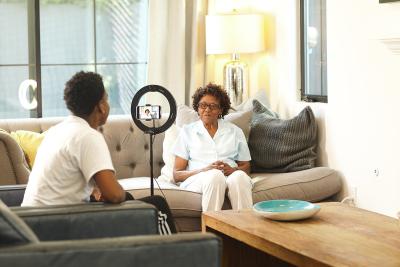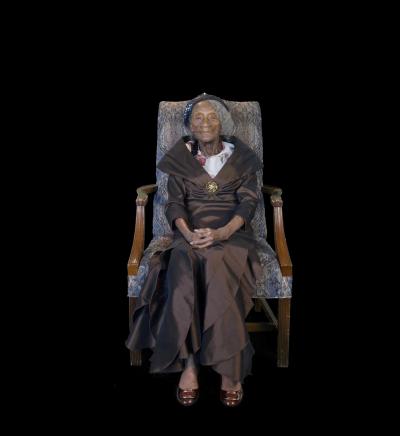As artificial intelligence (AI) continues to improve, it will further transform the way we create and interact with all forms of content. AI creative apps are already able to generate mind-blowing visuals with simple text prompts and are poised to drastically change the workflows of those in creative fields.
Also changing the way we interact with content through the use of AI is StoryFile, a software company powering AI conversational videos — called storyfiles — allowing for real-time interaction with recorded content. Instead of passively listening to information from a certain subject matter expert, StoryFile gives people the opportunity to ask questions and essentially have a conversation with the AI video.
Storyfiles can be viewed and interacted with online, but they can also be displayed in-person using vertical display screens and, in some cases, Proto hologram devices. For instance, they have been used at previous museum installations to enable conversations with Holocaust survivors, as well as at events like last year’s Miami Crypto Experience, where an AI hologram of famous tech investor Tim Draper appeared via Proto to deliver a keynote Q&A.

Ohio’s Maltz Museum is the latest museum to showcase the technology for an upcoming installation featuring civil rights leader Rev. Dr. Otis Moss Jr., but with a twist — in a first for StoryFile, the public is invited to help beta test Rev. Moss’s AI video before the exhibit officially opens on October 22nd.
“We like to always have some kind of beta version, but usually it’s behind closed doors,” explains StoryFile co-founder and CEO Stephen Smith. “What we like about doing it publicly is that you get a real sense of what genuinely interests people. AI training is only possible when you know what it is that people are interested in.”
By allowing the public to come and ask the AI questions, the StoryFile team is able to better hone the AI’s responses based on what it is most likely to be asked — for example, the initial video script may not have anticipated a certain question or a certain phrasing, but the storyfile more than likely has content that would make for an appropriate response. In this case, the team can direct the AI’s response if it comes across the same question again.
“It [the AI] knows when it’s succeeded and it knows when it's failed, but it doesn't know in the middle, and that's where the beta testing comes in,” says Smith. “Once you get lots of inputs — in this case from the public, which is extremely helpful — it enables you to deal with all those orange cases.”
Museum visitors are not given any direction about what they can and can’t ask, but they are given a few tips about what might be a good first question, such as “What’s your story?” which will prompt the AI to briefly tell the individual’s basic story and “What can I ask you about?” which will give the asker some ideas about topics covered in the storyfile that they can learn more about.
“The good thing about the Otis Moss interview is that it's very wide ranging, so we have what we would call an open dialogue format,” explains Smith. “There should be enough content for the audience to be able to go in any direction, and what's helping is that around the installation, there is lots of context. So you're meeting Otis Moss in the context of an exhibition about Cleveland and the civil rights movement. It’s unlikely that you’d be asking about baseball.”
In addition to creating unique, interactive, and educational exhibits in and of themselves, storyfiles also tend to have an interesting effect on the way visitors experience the museum. “One of the things that I like most is when people engage with a storyfile together — and they’re not necessarily people that know each other. Often it's just a bunch of people that happen to be there at that time,” says Smith.
Last year, for the 100th anniversary of the Tulsa race massacre, StoryFile created conversational videos of two survivors, which were presented at the Gilcrease Museum in Tulsa. Smith sat in the museum for a couple of days, watching people come and interact with the AI videos.

“It was fascinating to watch people talking who had never met each other — talking about the race massacre, and what they were learning, and then asking the storyfile more questions together,” he shares. “There’s this sort of social learning going on, and it's something I've observed a lot in museums. I think a side benefit of this where people get to meet each other as well as getting to meet this character and learn from one another. That's one of the things I find most interesting about how storyfiles work in a museum context.”
The installation at the Maltz Museum and the way it’s been trained and implemented has exciting implications for other projects in art, music, history, culture — and even wider reaching applications. Smith notes that he hopes museums adopt storyfile videos as a standard practice for people to be able to learn directly from historical figures, but the potential of the technology is vast.
“Basically, wherever there's a question to be asked, you could get an answer from StoryFile,” he says. “I would see it as the next version of Wikipedia at some point. We only know what we know in the world because people know it, and we only have the experiences we have in the world because people live it. We are the sum of all of our experiences, and what we do right now is curate that into sunsets on Instagram, birthday parties on FaceTime and rants on Twitter.
“What we're really interested in is how we can actually preserve and collect all of our stories to create an archive of humanity. I’d like there to be 100 million stories on the StoryFile platform, because until you get to that level, you've not even started to tell the story of our world. I think we can learn from each other and have this amazing experience where folks are just ‘sitting’ in your living room and you're talking and engaging like you’re having an afternoon chat with them. It's going to be as ubiquitous as that.”
Those interested in helping to beta test Rev. Moss's AI can gain free admission to the Maltz Museum now through October 22, every Tuesday, Thursday, and Saturday at 2:00pm.